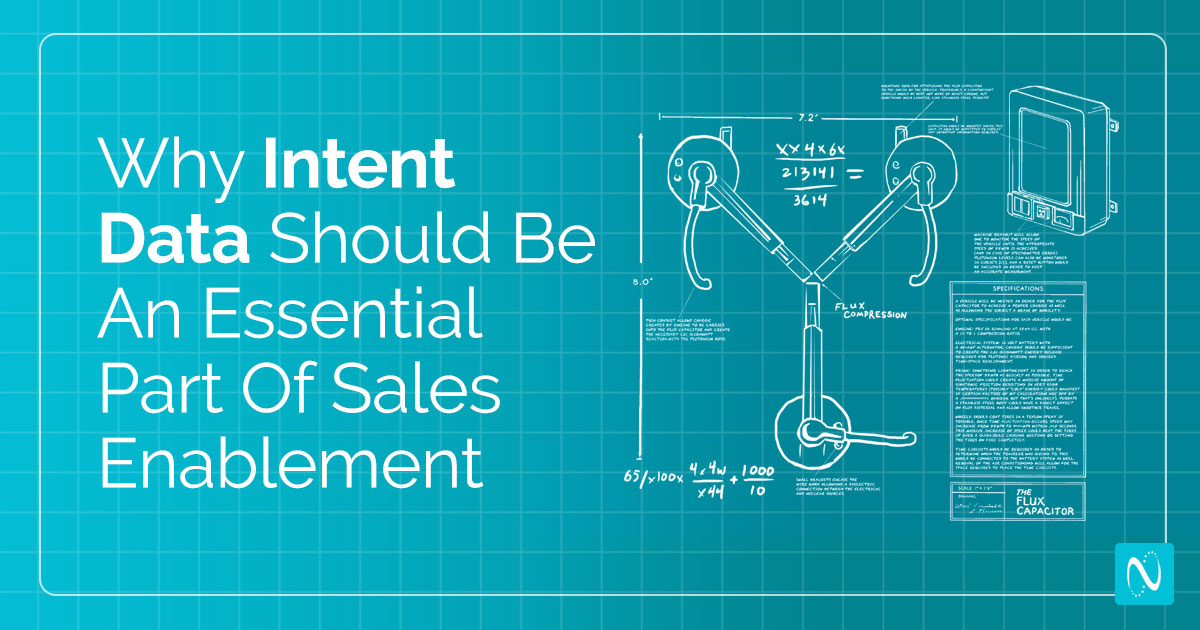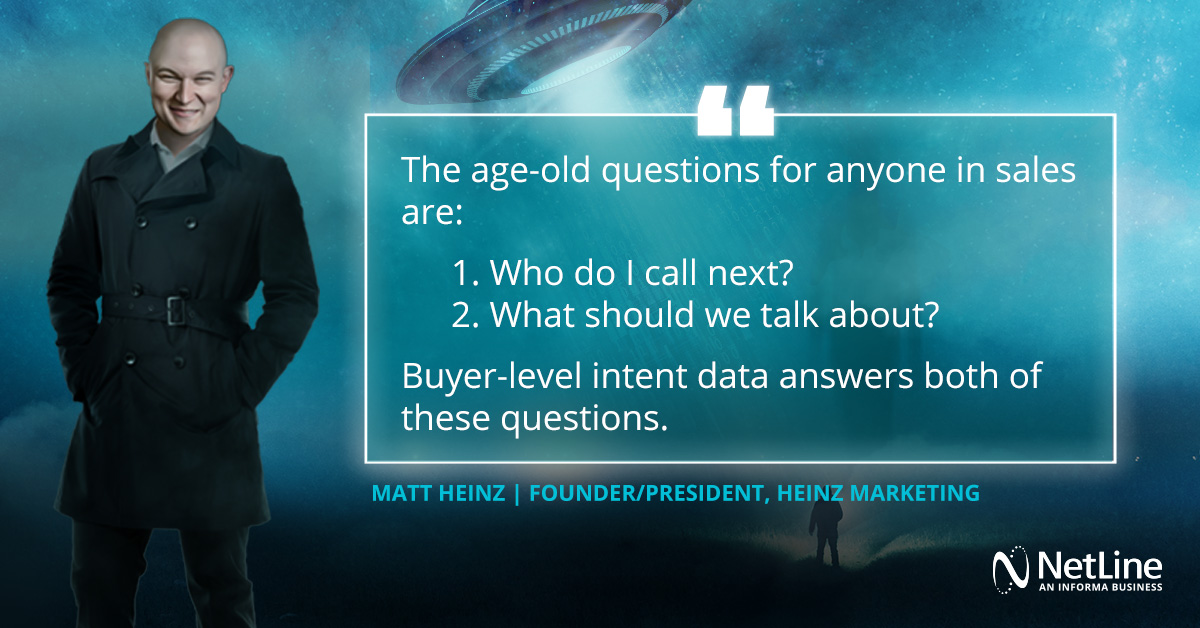In a previous post, we covered how to get the sales handoff right and why first-party and validated buyer data is essential in this process.
It’s important to realize that although intent data has played a major role in discovering and nurturing leads before being handed over to sales, its job isn’t finished at that handover. There is still work that intent data can do.
Here’s a look at sales enablement and why intent data should play a part in this vital part of the sales process.

Luna is hard at work on her flux capacitor, fusing intent data into her sales approach. [Image via ChatGPT]
How does intent data support the sales enablement process?
Let’s start off with a quick definition, as Oracle defines it:
Sales enablement is the set of tools and content provided to your sales teams to help them sell smarter and sell more.
Sales enablement also includes the processes that marketers undertake to help sales reps sell. This encompasses everything that’s done to generate leads, manage those leads and then hand those leads over to the sales team.
According to Gartner, sales enablement is owned by both sales and marketing, with marketing being responsible for creating resources, including content, messaging, and training. In fact, sales enablement is the top sales activity that marketing is actively involved in.
But where does intent data fit into the equation? If you are unsure what intent data is, have a look at our post on buyer-level intent for a detailed exploration of this crucial form of data.
Intent data, especially at the buyer level, reveals the interests and behaviors of your target buyers.
Think of intent data as the digital footprints left by your prospects, revealing insights into what they are searching for, the content they engage with, and the online behavior that points towards their readiness to purchase.
This game-changing intelligence is key for sale enablement as it arms sales teams with valuable information about their buyers: They know who the buyer is and what their needs are.
This, in turn, permits sales to custom-fit their outreach and messaging so that it’s meaningful, personalized, and relevant.
Additionally, buyer-level intent data allows sales teams to discern between lukewarm leads and those showing high engagement and interest. Being able to prioritize allows sales teams to concentrate their efforts more efficiently and funnel their attention to those leads that are most likely to convert.
What are the benefits of incorporating intent data into sales enablement initiatives?
We have already covered how intent data supports sales enablement by providing sales teams with useful and relevant data about buyers, but what are the tangible benefits of integrating intent data into your sales enablement initiatives? Let’s have a look.
Improved lead quality:
This benefit starts well before a buyer appears on sales’ radar. Buyer-level intent data ensures better quality leads are being passed from marketing to sales because marketing is able to see what a buyer is engaging with, why they are doing so, and, most importantly, who that buyer is.
When that lead is handed over to sales, they already know who they are engaging and their pain points. They also know that the buyer is in the late stage of their journey and ready to make a purchase decision.
More efficient sales processes:
Sales can be tricky business, especially if you don’t really know who you are selling to. If you are relying solely on account-level intent data, you’ll have some inkling into the account but you don’t know who you are selling to.
Not knowing the who can often feel like you’re wasting time and resources on chasing an account and never getting to a person. However, with buyer-level intent data, sales processes are more efficient because you have access to the who but also the why and when.
As Matt Heinz, Founder/President of Heinz Marketing, explains in NetLine’s The Proof is Out There report:
Buyer-level intent data answers both of these questions. It’s not just about ‘who’ to call. When you add ‘why’ and ‘when,’ it’s like adding rocket fuel to your sales engagement, productivity and conversion metrics.
Increased conversion rates:
We saved the best for last because the ultimate goal in sales is to convert a prospect into a customer. It’s not always an easy task, but understanding a buyer’s needs and preferences is half the battle won.
By using customer intent data, sales teams are able to tailor their messaging and outreach in a way that resonates with the buyer’s interests and solves their pain points, leading to higher engagement and, subsequently, higher conversion rates.
How can sales teams use intent data to improve their understanding of buyer needs and preferences?
So, how can sales teams use intent data to improve their understanding of buyer needs and preferences?
We already know that buyer-level intent data reveals who the buyer is. If you have the right technology, you can also answer the all-important questions of what, when, and where.
What actions is the buyer taking? When are these actions taking place? And, where did the actions occur?
With this information, sales can hold much more efficient discovery calls because they already have answers to many of the basic questions.
They are aware of the topics the buyer has been exploring and, therefore, have a much firmer grasp of the buyer’s pain points and the problems they are trying to solve. This enables sales to style their outreach in a more personalized and precise way.
Moreover, with improved lead quality, sales will only be approaching buyers who are in-market and receptive to what’s on offer. No more wasting time and effort on prospects who aren’t ready to buy or aren’t showing interest in your product or service.
Finally, because sales know who the buyers are, they are able to identify the most important decision-makers and influencers within the target account. Again, this knowledge enables sales to focus their efforts on those individuals who have a say in buying decisions and can provide them with messaging and content that is relevant to their role.
How can intent data be used to create more effective sales collateral and resources?
Beyond informing outreach, intent data can be used to create more compelling sales collateral and resources. With the insights gained from intent data, sales teams can identify the themes that are most important to their target buyers. This information can then be used to develop engaging and relevant content that effectively addresses the needs of your audience.
Furthermore, intent data can shed light on the preferred formats and channels for content consumption. With this knowledge, sales teams can create resources that not only resonate with the target audience but are also delivered via the channels they’re most comfortable with.

When you enable your sales team with intent data, the space you can dominate is boundless. [Image via ChattGPT]
In the fast-paced, highly competitive world of B2B sales, buyer-level intent data provides the edge you need. The trail of useful data that your prospective buyers leave behind is waiting to be explored—don’t miss out on the insights it holds.

